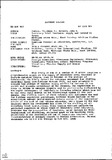| dc.description.abstract | This study is one of a series of 15 which comprises a comprehensive report on the supply of secondary level teachers in English-speaking Africa. Each is focused on the problem of determining the likely demand for overseas personnel for staffing secondary level institutions through 1975, and each attempts to analyze the problem of teacher supply within the context of the social and economic conditions of the country. The experience in Kenya is unique in several respects and is particularly influenced by the rapid development of self-help or harambee schools which have led to the very rapid growth of the educational system in the past decade. The staffing needs of these schools will influence the need for further expatriate assistance. Another unique feature is the recognition through newly-approved salary scales of the specialized nature of the task of the teacher educator, and a third is the high priority which the government has given to the staffing of all secondary level institutions. Other topics examined include the projected expansion of other types of secondary level education, programs for the preparation of teachers, major factors in their recruitment and retention, projected gaps in the teaching force, priorities in the provision and use of expatriate teachers, and recommendations of primary concern to Kenyan authorities | en_US |

